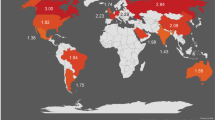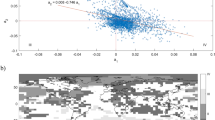Abstract
Changes in subseasonal temperature variability are linked with the altered probability of weather extremes and have important impacts on society and ecological systems. Earlier studies based on observations up to 2014 have shown a general decrease in subseasonal temperature variability over Northern Hemisphere extratropical land. However, these changes have been confined to specific regions and seasons, have limited statistical significance and human influence is yet to be determined. Here we show using up-to-date observations and climate model simulations that a human fingerprint, or pattern of change, in subseasonal variability has recently emerged over the Northern Hemisphere extratropics. The fingerprint features decreased near-surface air temperature variability over land in the high-northern latitudes in autumn, further extending into mid-latitudes in winter. Using large ensembles of single-forcing model experiments, we attribute the pattern of reduced temperature variability primarily to increased anthropogenic greenhouse gas concentrations, with anthropogenic aerosols playing a secondary role. Our results reveal that human influence is now detectable in hemispheric-wide day-to-day temperature variability and motivates research into the impacts of reduced temperature volatility on societal and ecological systems.
This is a preview of subscription content, access via your institution
Access options
Access Nature and 54 other Nature Portfolio journals
Get Nature+, our best-value online-access subscription
$29.99 / 30 days
cancel any time
Subscribe to this journal
Receive 12 print issues and online access
$259.00 per year
only $21.58 per issue
Buy this article
- Purchase on Springer Link
- Instant access to full article PDF
Prices may be subject to local taxes which are calculated during checkout




Similar content being viewed by others

Data availability
CanESM2 data are available at https://open.canada.ca/data/en/dataset/aa7b6823-fd1e-49ff-a6fb-68076a4a477c. CESM1 data are available at https://www.earthsystemgrid.org/dataset/ucar.cgd.ccsm4.CESM_CAM5_BGC_LE.html. ERA5 reanalysis data are available at https://cds.climate.copernicus.eu/cdsapp#!/dataset/reanalysis-era5-single-levels?tab=overview. NCEP-DOE Reanalysis 2 data are available at https://psl.noaa.gov/data/gridded/data.ncep.reanalysis2.html. Berkeley Earth observations are available at http://berkeleyearth.org/archive/data/.
Code availability
Code is available form the corresponding author on reasonable request.
References
IPCC Climate Change 2013: The Physical Science Basis (eds Stocker, T. F. et al.) (Cambridge Univ. Press, 2013).
Screen, J. A. Arctic amplification decreases temperature variance in northern mid- to high-latitudes. Nat. Clim. Change 4, 577–582 (2014).
Rhines, A., McKinnon, K. A., Tingley, M. P. & Huybers, P. Seasonally resolved distributional trends of North American temperatures show contraction of winter variability. J. Clim. 30, 1139–1157 (2017).
McKinnon, K. A., Rhines, A., Tingley, M. P. & Huybers, P. The changing shape of Northern Hemisphere summer temperature distributions. J. Geophys. Res. Atmos. 121, 8849–8868 (2016).
Schneider, T., Bischoff, T. & Płotka, H. Physics of changes in synoptic midlatitude temperature variability. J. Clim. 28, 2312–2331 (2015).
De Vries, H., Haarsma, R. J. & Hazeleger, W. Western European cold spells in current and future climate. Geophys. Res. Lett. 39, L04706 (2012).
Dai, A. & Deng, J. Arctic amplification weakens the variability of daily temperatures over northern middle–high latitudes. J. Clim. 34, 2591–2609 (2021).
Linz, M., Chen, G. & Hu, Z. Large-scale atmospheric control on non-Gaussian tails of midlatitude temperature distributions. Geophys. Res. Lett. 45, 9141–9149 (2018).
Fischer, E. M., Lawrence, D. M. & Sanderson, B. M. Quantifying uncertainties in projections of extremes—a perturbed land surface parameter experiment. Clim. Dyn. 37, 1381–1398 (2011).
Fischer, E. M., Rajczak, J. & Schär, C. Changes in European summer temperature variability revisited. Geophys. Res. Lett. 39, L19702 (2012).
Collow, T. W., Wang, W. & Kumar, A. Reduction in northern midlatitude 2-m temperature variability due to Arctic sea ice loss. J. Clim. 32, 5021–5035 (2019).
Francis, J. A. & Vavrus, S. J. Evidence linking Arctic amplification to extreme weather in mid‐latitudes. Geophys. Res. Lett. 39, L06801 (2012).
Francis, J. A. & Vavrus, S. J. Evidence for a wavier jet stream in response to rapid Arctic warming. Environ. Res. Lett. 10, 014005 (2015).
Cohen, J. et al. Recent Arctic amplification and extreme mid-latitude weather. Nat. Geosci. 7, 627–637 (2014).
Cohen, J. et al. Divergent consensuses on Arctic amplification influence on midlatitude severe winter weather. Nat. Clim. Change 10, 20–29 (2020).
Santer, B. D. et al. Identifying human influences on atmospheric temperature. Proc. Natl Acad. Sci. USA 110, 26–33 (2013).
Santer, B. D. et al. Human influence on the seasonal cycle of tropospheric temperature. Science 361, eaas8806 (2018).
Chemke, R., Zanna, L. & Polvani, L. M. Identifying a human signal in the North Atlantic warming hole. Nat. Commun. 11, 1540 (2020).
Blackport, R. & Kushner, P. J. Isolating the atmospheric circulation response to Arctic sea ice loss in the coupled climate system. J. Clim. 30, 2163–2185 (2017).
Sun, L., Deser, C. & Tomas, R. A. Mechanisms of stratospheric and tropospheric circulation response to projected Arctic sea ice loss. J. Clim. 28, 7824–7845 (2015).
Screen, J. A., Deser, C. & Sun, L. Reduced risk of North American cold extremes due to continued Arctic sea ice loss. Bull. Am. Meteorol. Soc. 96, 1489–1503 (2015).
Chripko, S. et al. Impact of reduced Arctic sea ice on Northern Hemisphere climate and weather in autumn and winter. J. Clim. 34, 5847–5867 (2021).
Blackport, R. & Screen, J. A. Insignificant effect of Arctic amplification on the amplitude of midlatitude atmospheric waves. Sci. Adv. 6, eaay2880 (2020).
Shepherd, T. G. Atmospheric circulation as a source of uncertainty in climate change projections. Nat. Geosci. 7, 703–708 (2014).
Tamarin-Brodsky, T., Hodges, K., Hoskins, B. J. & Shepherd, T. G. Changes in Northern Hemisphere temperature variability shaped by regional warming patterns. Nat. Geosci. 13, 414–421 (2020).
IPCC Special Report on Managing the Risks of Extreme Events and Disasters to Advance Climate Change Adaptation (Cambridge Univ. Press, 2012); https://doi.org/10.1017/CBO9781139177245
Katz, R. W. & Brown, B. G. Extreme events in a changing climate: variability is more important than averages. Climatic Change 21, 289–302 (1992).
Vasseur, D. A. et al. Increased temperature variation poses a greater risk to species than climate warming. Proc. R. Soc. Lond. B 281, 20132612 (2014).
Thornton, P. K., Ericksen, P. J., Herrero, M. & Challinor, A. J. Climate variability and vulnerability to climate change: a review. Glob. Change Biol. 20, 3313–3328 (2014).
Hersbach, H. et al. The ERA5 global reanalysis. Q. J. R. Meteorol. Soc. 146, 1999–2049 (2020).
Kanamitsu, M. et al. NCEP–DOE AMIP-II Reanalysis (R-2). Bull. Am. Meteorol. Soc. 83, 1631–1644 (2002).
Rohde, R. A. & Hausfather, Z. The Berkeley Earth land/ocean temperature record. Earth Syst. Sci. Data 12, 3469–3479 (2020).
Arora, V. K. et al. Carbon emission limits required to satisfy future representative concentration pathways of greenhouse gases. Geophys. Res. Lett. 38, L05805 (2011).
Kirchmeier-Young, M. C., Zwiers, F. W. & Gillett, N. P. Attribution of extreme events in Arctic sea ice extent. J. Clim. 30, 553–571 (2016).
Hurrell, J. W. et al. The Community Earth System Model: a framework for collaborative research. Bull. Am. Meteorol. Soc. 94, 1339–1360 (2013).
Kay, J. E. et al. The Community Earth System Model (CESM) large ensemble project: a community resource for studying climate change in the presence of internal climate variability. Bull. Am. Meteorol. Soc. 96, 1333–1349 (2015).
Schwalm, C. R., Glendon, S. & Duffy, P. B. RCP 8.5 tracks cumulative CO2 emissions. Proc. Natl Acad. Sci. USA 117, 19656–19657 (2020).
Acknowledgements
We thank the Canadian Centre for Climate Modelling and Analysis and the National Center for Atmospheric Research for performing the large-ensemble simulations and making the data available. We also thank the European Centre for Medium-Range Weather Forecasts, the National Centers for Environmental Prediction and Berkeley Earth for making the reanalysis and observational datasets available. J.A.S. was funded by UK Natural Environment Research Council grant NE/V005855/1.
Author information
Authors and Affiliations
Contributions
R.B. conceived of the study, carried out the analysis and wrote the manuscript. J.C.F. and J.A.S. discussed the results and made suggestions and edits to the manuscript.
Corresponding author
Ethics declarations
Competing interests
The authors declare no competing interests.
Additional information
Peer review information Nature Geoscience thanks Reindert Haarsma, Dáithí Stone and the other, anonymous, reviewer(s) for their contribution to the peer review of this work. Primary Handling Editor: Tom Richardson.
Publisher’s note Springer Nature remains neutral with regard to jurisdictional claims in published maps and institutional affiliations.
Extended data
Extended Data Fig. 1 Subseasonal near-surface temperature variability trends in reanalysis and observations.
Trends in subseasonal near-surface air temperature variability (°C/decade) in autumn (SON; a, c, e) and winter (DJF; b, d, f) over the 1979-2018 period. Trends are shown for ERA5 reanalysis (a, b) NCEP-DOE-reanalysis 2 (c, d), and Berkeley Earth observations (e, f). The stippling indicates trends that statistically significant at the 5% level using a two-sided student’s t-test.
Extended Data Fig. 2 Subseasonal near-surface temperature variability trends in spring and summer.
As in Fig. 1, but for spring (MAM) and summer (JJA).
Extended Data Fig. 3 Fingerprints of subseasonal temperature variability.
The fingerprints of subseasonal temperature variability from CanESM2 (a, b) and CESM1 (c, d) for autumn (SON; a, c) and winter (DJF; b, d).
Extended Data Fig. 4 Signal-to-noise ratios for increasing trend length.
As in Fig. 3, but with grid-points over ocean included in the fingerprint.
Extended Data Fig. 5 Subseasonal near-surface temperature variability trends.
As in Fig. 1, but with grid points over ocean included.
Extended Data Fig. 6 Seasonal-mean near-surface temperature trends.
As in Fig. 4, but for seasonal-mean temperature trends (°C/decade).
Extended Data Fig. 7 Meridional temperature gradient trends.
As in Fig. 4, but for meridional temperature gradient trends (°C 1000 km−1 decade−1).
Rights and permissions
About this article
Cite this article
Blackport, R., Fyfe, J.C. & Screen, J.A. Decreasing subseasonal temperature variability in the northern extratropics attributed to human influence. Nat. Geosci. 14, 719–723 (2021). https://doi.org/10.1038/s41561-021-00826-w
Received:
Accepted:
Published:
Issue Date:
DOI: https://doi.org/10.1038/s41561-021-00826-w
This article is cited by
-
Response of winter climate and extreme weather to projected Arctic sea-ice loss in very large-ensemble climate model simulations
npj Climate and Atmospheric Science (2024)
-
Earlier spring greening in Northern Hemisphere terrestrial biomes enhanced net ecosystem productivity in summer
Communications Earth & Environment (2024)
-
Influence of the mid-high-latitude Eurasian ISO on PM2.5 concentration anomaly in North China during boreal winter
Climate Dynamics (2024)
-
Decadal trend of synoptic temperature variability over the Northern Hemisphere in winter
Theoretical and Applied Climatology (2023)
-
Deforestation intensifies daily temperature variability in the northern extratropics
Nature Communications (2022)


